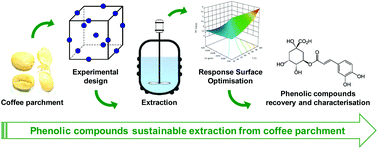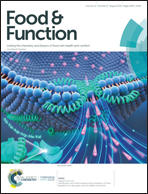Response surface methodology to optimise the heat-assisted aqueous extraction of phenolic compounds from coffee parchment and their comprehensive analysis†
Abstract
Coffee parchment is one of the less studied coffee by-products, being rich in phenolic compounds. The objective of this study was to revalorise coffee parchment, obtaining aqueous extracts rich in phenolic compounds, optimising the extraction conditions using response surface methodology and comprehensively characterising the obtained extracts. A Box–Behnken design was used to maximise the recovery of total phenolic compounds, total flavonoids, total flavanols, total phenolic acids, and total ortho-diphenols, and the antioxidant capacity of coffee parchment extracts. The main factor influencing phenolic compound extraction was temperature, followed by solid-to-solvent ratio and acidity. Optimised heat-assisted extraction conditions were 100 °C, 90 min, 0% citric acid, and 0.02 g mL−1 solid-to-solvent ratio. Under these conditions, the concentrations of phenolic compounds and antioxidant capacity were equivalent to those expected, allowing us to validate the model. The UPLC-ESI-MS/MS phenolic profile exhibited the occurrence of 13 phenolic compounds, with those shown in higher concentrations being chlorogenic acid, vanillic acid, protocatechuic acid, and p-coumaric acid. The findings of this study provide valuable insights into the potential application of a useful, clean, environmentally friendly and cost-effective method to recover phenolic compounds from coffee parchment and, thus, to revalorize the by-product by converting it into high-added value new products to be used in the food and cosmetic industries.



 Please wait while we load your content...
Please wait while we load your content...